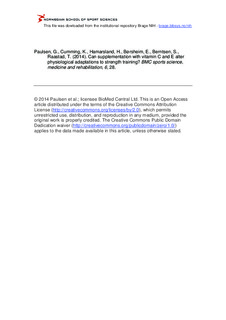| dc.contributor.author | Paulsen, Gøran | |
| dc.contributor.author | Cumming, Kristoffer Toldnes | |
| dc.contributor.author | Hamarsland, Håvard | |
| dc.contributor.author | Børsheim, Elisabeth | |
| dc.contributor.author | Berntsen, Sveinung | |
| dc.contributor.author | Raastad, Truls | |
| dc.date.accessioned | 2015-06-03T10:27:14Z | |
| dc.date.available | 2015-06-03T10:27:14Z | |
| dc.date.issued | 2014-07-05 | |
| dc.identifier.citation | BMC Sports Science, Medicine and Rehabilitation. 2014, 6, 28 | nb_NO |
| dc.identifier.uri | http://hdl.handle.net/11250/284498 | |
| dc.description | © 2014 Paulsen et al.; licensee BioMed Central Ltd. This is an Open Access article distributed under the terms of the Creative Commons Attribution License (http://creativecommons.org/licenses/by/2.0), which permits unrestricted use, distribution, and reproduction in any medium, provided the original work is properly credited. The Creative Commons Public Domain Dedication waiver (http://creativecommons.org/publicdomain/zero/1.0/) applies to the data made available in this article, unless otherwise stated. | nb_NO |
| dc.description.abstract | Background: Antioxidant supplementation has recently been demonstrated to be a double-edged sword, because small to moderate doses of exogenous antioxidants are essential or beneficial, while high doses may have adverse effects. The adverse effects can be manifested in attenuated effects of exercise and training, as the antioxidants may shut down some redox-sensitive signaling in the exercised muscle fibers. However, conditions such as age may potentially modulate the need for antioxidant intake. Therefore, this paper describes experiments for testing the hypothesis that high dosages of vitamin C (1000 mg/day) and E (235 mg/day) have negative effects on adaptation to resistance exercise and training in young volunteers, but positive effects in older men.
Methods/design: We recruited a total of 73 volunteers. The participants were randomly assigned to receiving either vitamin C and E supplementation or a placebo. The study design was double-blinded, and the participants followed an intensive training program for 10–12 weeks. Tests and measurements aimed at assessing changes in physical performance (maximal strength) and physiological characteristics (muscle mass), as well as biochemical and cellular systems and structures (e.g., cell signaling and morphology).
Discussion: Dietary supplements, such as vitamin C and E, are used by many people, especially athletes. The users often believe that high dosages of supplements improve health (resistance to illness and disease) and physical performance. These assumptions are, however, generally not supported in the scientific literature. On the contrary, some studies have indicated that high dosages of antioxidant supplements have negative effects on exercise-induced adaptation processes. Since this issue concerns many people and few randomized controlled trials have been conducted in humans, further studies are highly warranted. | nb_NO |
| dc.language.iso | eng | nb_NO |
| dc.publisher | BioMed Central | nb_NO |
| dc.subject | protocol paper | nb_NO |
| dc.subject | antioxidants | nb_NO |
| dc.subject | muscle mass | nb_NO |
| dc.subject | muscle strength | nb_NO |
| dc.subject | 1 repetition maximum | nb_NO |
| dc.title | Can supplementation with vitamin C and E alter physiological adaptations to strength training? | nb_NO |
| dc.type | Journal article | nb_NO |
| dc.type | Peer reviewed | nb_NO |
| dc.subject.nsi | VDP::Medical disciplines: 700::Sports medicine: 850 | nb_NO |
| dc.source.journal | BMC Sports Science, Medicine and Rehabilitation | nb_NO |
| dc.description.localcode | Seksjon for fysisk prestasjonsevne / Department of Physical Performance | nb_NO |
